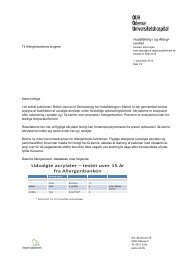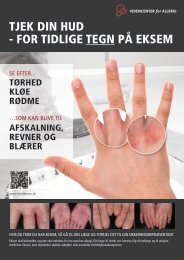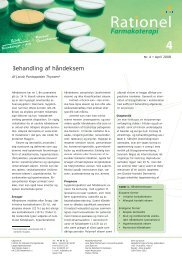Charlotte Devantier Jensen.pmd - Videncenter for Allergi
Charlotte Devantier Jensen.pmd - Videncenter for Allergi
Charlotte Devantier Jensen.pmd - Videncenter for Allergi
Create successful ePaper yourself
Turn your PDF publications into a flip-book with our unique Google optimized e-Paper software.
6 <strong>Charlotte</strong> <strong>Devantier</strong> <strong>Jensen</strong><br />
ognition of the hapten-protein complex by antigen-presenting<br />
Langerhans cells (LCs), the antigen is processed into smaller<br />
peptide fragments in the cell. LCs are epidermal, dendritic cells<br />
with the main function of internalizing, processing, transporting,<br />
and presenting encountered antigen 24 . The processed hapten<br />
then <strong>for</strong>ms complexes with major histocompatibility complex<br />
(MHC) proteins and the complex is presented on the surface<br />
of the LCs. A hapten-induced cytokine production activates<br />
the LCs that, via the afferent lymphatics, migrate to the<br />
local lymph nodes presenting the hapten-MHC molecule complexes<br />
to naïve T lymphocytes. When a hapten-specific T<br />
lymphocyte recognizes the antigen-complex via its T cell antigen<br />
receptor, the presenter cell and the T cell bind to each<br />
other facilitated by a number of adhesion molecules. The contact<br />
between the cells and <strong>for</strong>mation of cytokines stimulates<br />
the activation of the T cell and the activated T cell starts proliferating<br />
and differentiating 25 . The antigen-specific memory-cell<br />
progeny is then released into the blood flow and begins to recirculate.<br />
An up-regulation of skin-homing molecules will assist<br />
their movement into peripheral tissues such as the skin 26 .<br />
Now the person is sensitized and the immune system is prepared<br />
to respond to allergen re-exposure. Upon challenge, a<br />
stronger and faster secondary immune response is triggered.<br />
Allergen-specific memory T cells will be mobilized to the exposure<br />
site. The cells will encounter antigen-presenting cells<br />
and pro-inflammatory cytokines are released, giving rise to<br />
the response clinically recognized as allergic contact dermatitis<br />
23 . The elicitation process is a delayed process compared to<br />
immediate allergic reactions, as the accumulation of allergenspecific<br />
T cells and the production of cytokines take time.<br />
COSMETIC PRESERVATIVES<br />
Biocides or preservatives are highly protein-reactive chemical<br />
substances able to control the growth of microorganisms like<br />
bacteria, fungi and yeast by disturbing basic functions of the<br />
target organism. They are added to a wide range of water-based<br />
products to protect them from the damaging effects of microorganisms.<br />
One product group utilizing preservatives is cosmetics. Legally,<br />
in the Cosmetics Directive of the European Union (EU),<br />
preservatives are defined as: “substances which may be added<br />
to cosmetic products <strong>for</strong> the primary purpose of inhibiting the<br />
development of micro-organisms in such products” 27 . Cosmetic<br />
products are expected to keep <strong>for</strong> a long time and are at the<br />
same time often stored in the warm, humid environment of a<br />
bathroom <strong>for</strong> long periods of time, providing ideal growth conditions<br />
<strong>for</strong> microorganisms. Preservatives are added to cosmetic<br />
products to protect the consumer from pathogenic microorganisms<br />
and to prevent spoilage such as discolouration,<br />
<strong>for</strong>mation of malodours, and physical and chemical degradation<br />
of the products. An ideal cosmetic preservative would have<br />
the following properties 28,29 :<br />
– Effective at low concentrations against a wide spectrum of<br />
microorganisms<br />
– Soluble in the <strong>for</strong>mulation at the required concentration<br />
– Non-toxic and non-sensitizing to the consumers at in-use<br />
concentrations<br />
– Compatible with other ingredients in the product<br />
– No physical effects on the product<br />
– Stable over a wide range of pH and temperature<br />
– Low toxicity to aquatic organisms<br />
Forum <strong>for</strong> Nord Derm Ven Vol. 10, 2005 – Suppl. 8<br />
– Easily biodegradable under aerobic and anaerobic conditions<br />
– Low potential <strong>for</strong> bioaccumulation<br />
However, no single preservative possesses all of these properties<br />
<strong>for</strong> all <strong>for</strong>mulations, so often a combination of two or more<br />
preservatives is added.<br />
The use of preservatives in cosmetic products is restricted.<br />
For health safety reasons Annex VI of the EU Cosmetics Directive<br />
27 comprises a positive list of the substances permitted<br />
as preservatives. Some of the preservatives are listed with restrictions,<br />
such as a maximum allowed level of use, a prohibition<br />
of use in oral care products, or a restriction of use to rinseoff<br />
products only (e.g. shampoos, soaps). All preservatives<br />
added to a cosmetic product must be declared on the product<br />
labelling by its INCI (International Nomenclature of Cosmetic<br />
Ingredients) name.<br />
Contact allergy to cosmetic preservatives<br />
Preservatives are biologically reactive chemicals, not only<br />
against microorganisms, but towards the human organism as<br />
well and there<strong>for</strong>e have an expected irritant and allergenic<br />
potential. Inherently, the more reactive and thereby efficient a<br />
preservative is, the more allergenic it usually is. Also, the greater<br />
the exposure to a preservative in dose per unit area of skin<br />
is, the greater the number of allergic responses to a product<br />
will be. Thus, the lowest possible use concentration with sufficient<br />
antimicrobial effect of a preservative is to be preferred<br />
as regards safety. As mentioned, two or more preservatives are<br />
often combined in cosmetic <strong>for</strong>mulations to obtain the desired<br />
properties and biocidal effects from the collective per<strong>for</strong>mance<br />
of the preservatives. This is also an advantage considering<br />
safety, as this allows <strong>for</strong> the use of lower and thereby safer<br />
concentrations of the preservatives.<br />
Following fragrances, preservatives are the most frequently<br />
sensitizing ingredients in cosmetic products and 4 preservatives<br />
are at this time included in the European standard patch<br />
test series: methylchloroisothiazolinone/ methylisothiazolinone<br />
(Kathon CG), <strong>for</strong>maldehyde, parabens, and quaternium 15<br />
(Dowicil 200). As recommended by the European Society of<br />
Contact Dermatitis (ESCD), a number of clinics additionally<br />
routinely test with a range of other preservatives, such as methyldibromoglutaronitrile<br />
(MDBGN), 3-iodo-2-propynylbutylcarbamate<br />
(IPBC), imidazolidinyl urea (Germal 115),<br />
diazolidinyl urea (Germal II ) to monitor the frequency of sensitivity<br />
to these chemicals.<br />
RISK ASSESSMENT OF COSMETIC PRODUCTS<br />
As consumers are becoming more aware of issues like health,<br />
product quality, animal testing and environmental safety, there<br />
is an increasing requirement <strong>for</strong> preservatives to be proven safe<br />
as well as effective in use. Also, according to the EU Cosmetics<br />
Directive, cosmetic products must not cause harm to human<br />
health when used under normal and <strong>for</strong>eseeable conditions.<br />
There<strong>for</strong>e products must be demonstrated to be essentially<br />
safe prior to release. The extrapolation from small scale<br />
tests to exposure of a large population of consumers will, nevertheless,<br />
most often result in some complaints of unwanted<br />
effects. Some temporary health effects, such as slight irritation,<br />
may be acceptable, whereas adverse and permanent effects<br />
are not. For instance, the ability of chemicals to sensitize

















